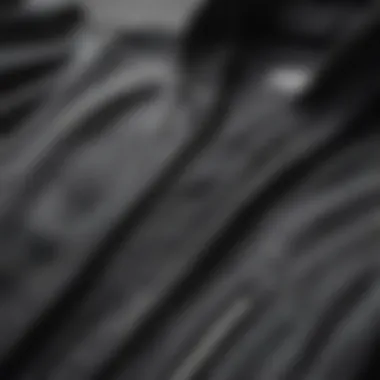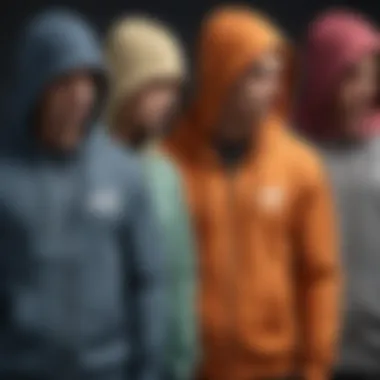The Evolution of the Hooded Zip-Up Sweatshirt in Skateboarding


Intro
The hooded zip-up sweatshirt holds a unique place in the fabric of skateboarding culture, threading together practical needs and stylistic preferences. Its evolution mirrors the growth of skateboarding itself, from its early days as a niche pastime to a globally recognized sport. This garment isn’t just clothing; it signifies a statement of identity, a shield against the elements, and a canvas for personal expression. In examining how this apparel became intertwined with skate culture, we uncover the nuances that elevate it beyond mere fashion to something more significant.
Throughout this article, we will delve into various facets of the hooded zip-up sweatshirt, exploring its history, cultural implications, and stylistic evolution in skateboarding. We'll navigate through the ages—from its humble beginnings to its current status as a recognizable symbol within the skate community.
This exploration is not just an academic pursuit. For skateboarders, industry professionals, and enthusiasts alike, understanding this garment's role can enrich one’s appreciation of skateboarding as a lifestyle and art form. Whether considering the practical design, material choices, or how the garment fosters a sense of belonging within skating circles, every aspect contributes to its iconic status.
Let’s kick things off and skate into the depths of its influence.
Preface to the Hooded Zip-Up Sweatshirt
The hooded zip-up sweatshirt, often affectionately referred to as a "hoodie," has ingrained itself deeply into the fabric of skateboarding culture. Headed toward the skate parks, it’s one staple that everyone can relate to. Skateboarders, whether seasoned pros or newcomers, have adopted this garment not just for its practicality but also as a canvas of self-expression. With its unique blend of comfort, style, and mobility, the hoodie stands out in a crowd, assisting skaters in their pursuit of tricks and hangs alike.
Definition and Overview
At its core, the hooded zip-up sweatshirt is a versatile piece of clothing characterized by its front zip closure and attached hood. It is generally made from soft fabrics like cotton or fleece, which provide warmth and comfort. The design often features a pouch pocket in the front, perfect for stashing small essentials, be it a phone, wallet, or, for some, even a pack of skate wax.
The appeal of these sweatshirts lies not just in their practical attributes, but also in how they allow individuals to express their identities. Hoodies can resonate with different aesthetics—from the understated and minimal to those decked out in bold graphics and logos. Many skateboard brands, like Element and Supreme, have taken this garment and turned it into a statement of style, making it a must-have in the skating community.
Historical Context
The history of the hooded zip-up sweatshirt goes beyond simple fashion. Emerging in the 1930s, it was originally designed for utility—workers needed something practical to keep them warm. As time passed, it morphed into a symbol of rebellion, especially in the late '70s and '80s, when it began to permeate youth culture, thanks largely to the rise of skateboarding and hip-hop.
By the time the 1990s rolled around, the hoodie had solidified its place as not just a piece of clothing but a cultural icon embraced by skateboarders across the globe. It became particularly linked to the underground scene and soon transformed into a holistic representation of the urban lifestyle. As skateboarding flourished and branched out into various subcultures, the hooded zip-up sweatshirt was there, adapting and evolving.
The influence of influential skaters, who donned hoodies in memorable videos and pictures, further elevated this garment's status. It became a visual shorthand for association with a lifestyle marked by freedom, creativity, and community. Over the years, this evolution transformed the hoodie into a wardrobe essential, connecting generations of skaters through its enduring appeal.
Materials and Construction
Understanding the materials and construction of the hooded zip-up sweatshirt is essential for grasping its role in skateboarding culture. This popular apparel is not merely a fashion statement; it’s a blend of comfort, functionality, and identity. Skateboarders look for durability and style in their clothing, making these elements critical in the design and selection processes of materials.
Fabric Choices
Cotton
Cotton is often considered the bread and butter fabric in the world of casual wear, especially for skateboard apparel. One of its standout features is breathability. This allows skaters to wear their hoodies without overheating while performing technical tricks. The softness of cotton also contributes to comfort, making it a favored choice for long skate sessions.
Yet, cotton does have its downsides, particularly when it comes to water resistance. Skateboarding is often an outdoor activity, and if it starts to rain, a cotton hoodie can become heavy and uncomfortable. Additionally, it tends to lose its shape and may wear down faster than synthetic fabrics, especially after repeated wash cycles.
Polyester
On the flip side, polyester offers benefits that cotton cannot match. It’s a synthetic fabric known for its high durability and moisture-wicking capabilities. This feature is particularly attractive to skateboarders, as it helps to keep them dry during intense sessions. Polyester sweatshirts also tend to maintain their shape over time, providing longevity in the garment's lifespan.
However, the downside of polyester is its breathability compared to cotton. While it dries quickly, it can trap heat and sweat, which might be uncomfortable for skaters performing in warmer conditions. Plus, some individuals might find it less soft against the skin compared to cotton.
Blend Fabrics


Blend fabrics, such as a mix of cotton and polyester, have become quite popular in skateboarding apparel. They strike a balance between the comfort of cotton and the durability of polyester. The unique feature of these blends is the combination of softness and strength, allowing for both a comfortable fit and resistance to wear and tear.
Skaters may find blend fabrics especially appealing because they can enjoy the best of both worlds. Yet, some purists argue that blends might dilute the unique qualities found in both cotton and polyester. While blend fabrics are versatile, they may not offer the full range of characteristics that some dedicated skaters prefer.
Design Elements
Design elements in hooded zip-up sweatshirts significantly influence their appeal in skateboard culture.
Zipper Styles
The style of zipper used in a sweatshirt can affect not only the aesthetic but also the functionality. For instance, a metal zipper gives a rugged look which perfectly fits the street-style vibe of skate culture. Alternatively, plastic zippers are often lighter and less likely to snag the fabric, are sometimes chosen to enhance comfort and performance. This attention to detail is paramount in appealing to the skateboard community.
Advantageously, zippers allow for easy ventilation. Skaters can zip down when they need to cool off or easily take off the hoodie without fuss. The downside, however, is that zippers can malfunction, a potential worry when you're trying to get ready for a trick.
Hood Construction
The construction of the hood is another fundamental element. A well-designed hood can provide both style and utility during skating. Notably, a double-lined hood adds warmth, while a single-lined hood is often considered lighter and less bulky. The balance between comfort and protection is key here.
When the wind is whipping, a good hood can shield the skater's face, improving focus and visibility. However, if it’s too tight, it can restrict movement. Therefore, the right fit is crucial for both aesthetics and comfort.
Fit and Cut
Finally, the fit and cut of a hoodie determine how it sits on the body, which is vital for mobility. A looser fit allows greater movement during tricks, while a tailored cut might appeal to those who lean towards a more stylish look. Many skaters appreciate a design that gives plenty of room around the shoulders yet maintains a clean profile.
Keeping in mind the functional aspect, a good cut can also enhance overall performance. A snug fit that hinders movement can leave a skater feeling restricted. Therefore, finding the right balance is essential when selecting a hooded zip-up sweatshirt that fits both style and function.
Practical Benefits for Skateboarders
When looking at the hooded zip-up sweatshirt, it’s no mere piece of clothing—it serves several practical benefits that skateboarders truly appreciate. It’s not just about style; it’s about functionality too. Understanding what makes this garment indispensable in the skateboarding world can lend insight into its enduring popularity.
Comfort and Mobility
One of the foremost advantages of a hooded zip-up sweatshirt is the comfort it provides. Made primarily from soft, breathable materials, these sweatshirts cater to the active lifestyle of skateboarders. The loose fit often found in skater sweatshirts allows for a full range of motion, essential for executing tricks and maneuvers. When a skateboarder is on the board, the last thing they need is to feel constricted by their clothes.
The stretchiness of cotton blends or polyester materials used aids in this respect. Even after a long day of skating, the sweatshirt tends to feel good on the skin—there’s little to no chafing. Plus, many of these sweatshirts are designed to be worn over other layers, providing flexibility in temperatures without feeling bulky.
"A good skater knows their gear is as important as their board. You can’t pull off a kickflip if your clothes are holding you back."
Weather Protection
Skateboarding often takes place outdoors, and the weather can be unpredictable. The hooded zip-up sweatshirt serves as a lightweight barrier against the elements. Whether it’s a light drizzle or a chilling breeze, having a hooded sweatshirt on hand provides a layer of protection that can easily be zipped up or tossed in a bag when not needed.
- Rain Resistance: Some models come with moisture-wicking fabrics that help keep the body dry even in wet conditions—this is ideal during those unexpected showers.
- Temperature Control: The hood acts as a shield, keeping wind and cold at bay. When temperatures drop, skateboarders can simply pull the hood up for added warmth.
- Easy Layering: These sweatshirts can easily be layered over t-shirts and under jackets, allowing skaters to adapt quickly to changing temperatures without the hassle of changing their entire outfit.
Cultural Significance
The hooded zip-up sweatshirt transcends its practical origins, becoming a symbol rich with meaning and context within skateboarding culture. It represents more than just a piece of clothing; it embodies lifestyle, identity, and a sense of belonging. As skateboarders navigate the world, this garment has proven pivotal in expressing who they are, providing a canvas on which personal narratives can be painted.
Identity and Expression


Skateboarding has always been about individuality. The hooded zip-up sweatshirt serves as an extension of one’s personality. Each color, logo, and design choice reflects a skater’s taste and influences. Whether adorned with the imagery of a favorite skate brand or stylized with DIY modifications, these sweatshirts showcase uniqueness.
In the skate community, the line between fashion and identity blurs. A skater might don a baggy gray sweatshirt that signals a laid-back attitude, while another might opt for a bright, eye-catching piece that screams confidence. Such choices are not trivial; they tell stories of aspiration, rebellion, and, at times, nostalgia. For instance, the image of a skater in a vintage style, recalling the rebellious roots of the 90s, can evoke a variety of sentiments not only for the individual but for a generation deeply influenced by that era.
Furthermore, the hoodie has developed cultural connotations over time, sometimes associated with defiance or urban lifestyle. A single piece can evoke a myriad of responses, creating unspoken bonds among those who wear it. In a bustling skate park, spotting someone in a particular design or brand instantly creates a shorthand understanding and recognition, reinforcing connections amongst skaters.
Community and Belonging
The camaraderie within skateboarding is often illustrated by shared symbols, and the hooded zip-up is a prime example of this fabric of connection. It serves as a unifying element that fosters community among skaters. We can see this in skate meets and events where groups circulate in similar sweatshirt styles, creating a sense of belonging. It’s like a badge of honor, often worn during sessions to signify unity.
Within the skate culture, the significance extends to regional styles as well. In different locations, you might find the sweatshirt blended with local flairs and interpretations. In California, for instance, brands often incorporate vibrant prints that reflect the laid-back, surf-inspired lifestyle, while in the North, darker and heavier fabrics may dominate due to the atmospheric conditions.
As these communities rise and fall, the consistent thread remains—the hooded zip-up sweatshirt persists as a cherished item. New skaters often feel the weight of tradition and belonging with their first fitting of a classic design; it’s common for seasoned skaters to gift younger enthusiasts their own hoodies as rites of passage.
The community aspect is also mirrored online. Platforms like Reddit and Facebook have formed spaces where skate enthusiasts share their favorite hooded zip-up brands, swaps, and personal stories. These networks amplify the sweatshirt’s role in skate culture, transforming it from a mere article of clothing into a visual representation of the shared passion for skating.
Fashion Trends in Skateboarding
In skateboarding culture, fashion trends often serve as more than just surface-level aesthetic choices. They reflect the lifestyle, values, and community spirit of skateboarders. The hooded zip-up sweatshirt, in particular, has become a key player in this realm, bridging the gap between functionality and style. Skateboarders are inherently a part of a dynamic environment where trends arise and evolve rapidly, making it crucial to consider how these fashion choices symbolize identity and heritage.
Influence of Brands
Skateboarding brands like Supreme, Thrasher, and Vans have a profound impact on the evolution of fashion within the sport. These brands have hustled hard to create a connection with their audiences beyond mere merchandise. They have mastered the art of merging lifestyle with street credibility. The hooded zip-up, often adorned with logos or unique designs, is a canvas for expression and individuality.
- Cultural Context: Brands such as Anti-Hero and Baker Skateboards tap into nostalgic designs that resonate with the early skateboarding era, making subcultures feel important and valued.
- Limited Drops: The trend of limited releases has heightened demand and exclusivity, rendering certain sweatshirts a point of envy among skaters.
Moreover, these brands invest in grassroots marketing, collaborating with local skate shops, and sponsoring riders who embody the essence of skate culture. As a result, when a brand releases a new zip-up, it is not merely a piece of clothing; it carries with it a story, an ethos, and a sense of belonging—a badge of honor for those who wear it.
Collaboration with Artists
Artist collaborations have also played a vital role in shaping fashion in skateboarding. When artists like Keith Haring or Ed Templeton partner with skate brands, the resulting pieces often push creative boundaries and blur the lines between fine art and streetwear. These collaborations take the humble hooded zip-up and transform it into a piece of art that resonates not just with skate culture but with broader artistic movements.
- Unique Designs: Collaborations often result in exclusive, limited-edition designs that appeal to both skaters and art aficionados.
- Promotion of Creativity: They encourage a culture of innovation that reflects the idea that skateboarding is not merely a sport but also an artistic expression.
This synergy elevates the hooded zip-up beyond apparel; it becomes a platform where art, culture, and personal expression intersect. Artists’ viewpoints, styles, and philosophies provide layers to the product, making each zip-up unique and desirable.
Skateboarding is more than a sport; it is a lifestyle, a culture, and a way of expressing oneself through fashion.
Through the lens of branding and collaboration, the hooded zip-up sweatshirt continues to evolve, adapting to changing tastes while remaining a fundamental aspect of skateboarders' identity. The trends that emerge within this space are reflective of a broader narrative that combines heritage, community, and creative resilience.
Iconic Moments in Skateboarding Fashion
In the world of skateboarding, the hooded zip-up sweatshirt has made its mark beyond mere practicality. It's woven into the fabric of the culture, shaping identities and influencing trends. When we talk about iconic moments in skateboarding fashion, we can't overlook how these sweatshirts have been at the forefront, often becoming symbols of rebellion and self-expression.
Memorable Photoshoots
Photos capture the essence of skate culture, often immortalizing the spirit of the time. Think back to the legendary images of Tony Hawk in a zipped-up hoodie as he soared above the ramp. Such captures not only showcase the tricks but also reflect the style ethos of the era—the casual yet functional nature of the hoodie made it an ideal choice for action.


The 90s saw the rise of brands like Element and BMX, who frequently featured skateboarders clad in hoodies for their campaigns. These images were not just about showcasing a product; they revolved around a lifestyle, a way of viewing the world. Memorable photoshoots became a canvas for artistic expression, intertwining fashion and sport seamlessly. Skateboarders, known for their avant-garde styles, used these moments to highlight individuality, each hoodie telling a story of its own. Often, they paired these sweatshirts with distinct skate shoes, creating a quintessential look that spoke to the times.
Furthermore, social media has amplified these moments in recent years. An Instagram post featuring a notable skater in a signature hoodie can cause a ripple effect, influencing trends overnight. This immediacy and impact make photoshoots a significant aspect of skateboarding fashion, propelling the hooded zip-up sweatshirt into the spotlight as both a functional piece and a fashion statement.
Cinematic Representations
Movies have a way of immortalizing fashion trends, and skateboarding films are no exception. Classics like "Lords of Dogtown" not only recount the storied history of skateboarding but also highlight the attire—the hooded zip-up sweatshirt, in particular, plays a vital role in connecting the audience to the lifestyle. The film captures the gritty essence of southern California during the 70s, where sweatshirts depicted a laid-back yet edgy aesthetic.
Another notable example is "Mid90s," directed by Jonah Hill. This film dives deep into the world of skateboarding in Los Angeles, with characters frequently sporting hooded sweatshirts that reflect their personalities and the culture at large. The use of these garments sets the tone for the era being depicted and connects the audience emotionally with the characters.
Beyond Hollywood, documentaries like "Dogtown and Z-Boys" offer a raw look at skate culture, often featuring interviews with iconic skaters who reminisce about the fashion trends they embraced in their heyday. The hooded sweatshirt emerges as a thread that connects these narratives, representing comfort amidst the chaos of skateboarding and the struggles each skater faced.
In essence, the impact of the hooded zip-up sweatshirt in both photoshoots and films transcends its physical presence. It signifies an immersive culture, a community, and a means of self-expression among skateboarders. As we watch these moments unfold, it becomes evident that this simple piece of clothing holds a depth of meaning that resonates with many.
The hooded zip-up sweatshirt isn't just about warmth; it's a canvas for stories, identity, and community in skateboarding.
The Evolution of the Hooded Zip-Up Sweatshirt
The hooded zip-up sweatshirt is not just clothing; it’s a symbol woven into the very fabric of skateboarding culture. This evolution reflects a blend of practicality, identity, and style that resonates with skaters around the globe. As the landscape of fashion merges with the world of skateboarding, understanding the journey of this iconic garment becomes crucial.
From Streetwear to High Fashion
Initially rooted in the skater’s need for comfort and function, the hooded zip-up sweatshirt began as a utilitarian piece. It served a purpose—offering a layer of warmth, a barrier against the elements, and pockets to stash essentials like keys or a small wallet. But as the skateboarding community grew, so did its sartorial significance.
In the 1980s, skate culture took off, and with it, so did streetwear as a recognizable style. The hooded sweatshirt became juxtaposed with urban aesthetics, allowing skaters not just to ride in comfort but also to express their individuality. Brands like Stüssy and Supreme began crafting sweatshirts that appealed not only for their durability but also for their cool, laid-back vibes.
Fast forward a few decades, and you’ll see names like Off-White and Fear of God adopting elements of skate style into high fashion. The once humble hooded sweatshirt made its way down runways, wearing an aura of luxury that stunned both fashionistas and skaters alike.
When the hooded zip-up transitioned from mere streetwear to haute couture, it symbolized a bigger cultural shift—one where the skateboarding ethos of rebellion broke down barriers and brought about a new acceptance of styles that embrace the edgy and casual. This evolution is now seen as the lines between skateboarding gear and high fashion continue to blur, pushing skaters to foreground their lifestyles in both street and high-end settings.
Current Trends and Future Directions
The current fashion scene shows an interesting blend. Limited edition releases and collaborations create urgency and excitement around the hooded sweatshirt. Yet, while style remains important, skaters often prioritize comfort and function more than anything. Inspired by boarders, eco-conscious brands are delving into sustainable materials, ensuring that what you wear while performing tricks is not only trendy but aligned with the growing ecological concern.
The hooded zip-up continues to adapt to changing styles and societal trends. Designs often include oversized fits and bold graphics, enhancing that unmistakable street vibe. The use of technology is also becoming prevalent—think breathable fabrics for hot days or moisture-wicking materials perfect for intense sessions near skate parks.
As we look ahead, it’s clear that the evolution of the hooded zip-up sweatshirt in skate culture is far from a finished chapter. Innovations in tailoring and sustainability might continue to shape its future, blending completely functional wear with artistic expression. With youth culture always seeking new forms of self-expression, one can only speculate the lengths to which this celebrated piece of apparel will evolve.
"The hoodie is not just about warmth or style; it’s about identity and expression. It’s a bridge between worlds."
Ending
The examination of the hooded zip-up sweatshirt within skateboarding culture reveals its profound impact on both personal identity and community dynamics. This apparel has transcended mere functionality, knitting itself into the social fabric of skate culture. Understanding its evolution not only allows enthusiasts to appreciate its significance but also sheds light on the future trajectory of fashion in this realm.
Summary of Key Points
- Historical Context: The hooded zip-up sweatshirt emerged from the streets, adopted for its practical benefits as well as its aesthetic appeal. From its roots in early skate culture to becoming a staple in high fashion, it reflects broader socio-cultural shifts.
- Practical Benefits: Comfort, mobility, and weather protection are paramount for skateboarders. The sweatshirt offers a perfect blend of these advantages, allowing skaters to perform unrestricted.
- Cultural Significance: Beyond just a garment, the hooded zip-up has become a symbol of identity and expression, enabling individuals to showcase their unique styles while fostering a sense of community among skaters.
- Fashion Trends: From collaborations with high-profile brands to the influence of grassroots movements, the sweatshirt has evolved in tandem with the changing landscape of skate fashion.
- Iconic Moments: Memorable photoshoots and cinematic representations have solidified its place as not just clothing, but a lifestyle emblem that resonates with countless fans of the culture.
The Future of Apparel in Skateboarding
Looking ahead, the future of apparel in skateboarding appears bright, and hoodie styles will likely continue to evolve. Considerations for sustainability will play a key role in shaping material choices. Brands are increasingly leaning towards environmentally friendly options like organic cotton and recycled fabrics.
Moreover, the intersection of technology and clothing is poised to have a major influence. Features like moisture-wicking materials and built-in LED lights may soon make their way into the designs, enhancing both functionality and safety.
The future may also see a surge in inclusivity in design, offering a broader range of sizes and styles to cater to all skaters. The ethos of skateboarding encourages self-expression and individuality, and the hooded zip-up sweatshirt will undoubtedly remain a canvas for that expression. With ongoing collaborations and innovative designs, this piece of apparel will hold its ground as a cultural staple, further entwining itself with the evolving identity of skateboarding.







